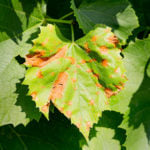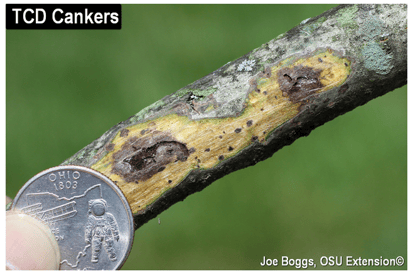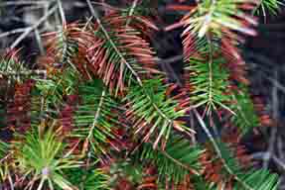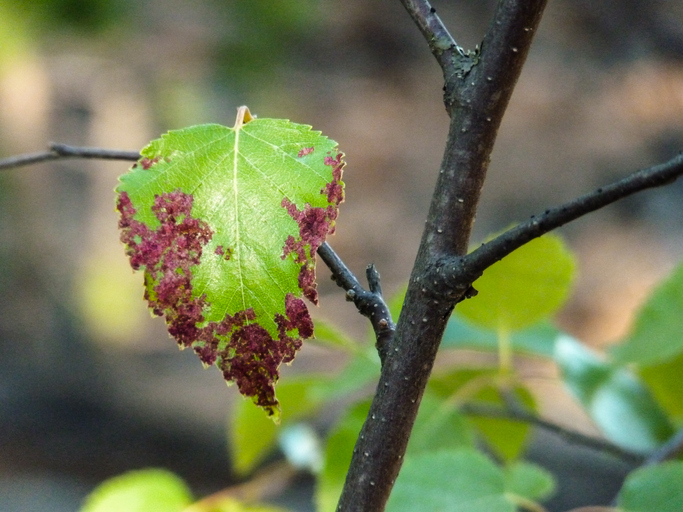.png)
6 Diseases That May Affect Your Trees in a Michigan Summer
We all love the warmth that summer brings, but heat and humidity helps diseases spread in trees in summer. Trees in Michigan are susceptible to this. It’s important that we take care of them because they’re an intrinsic part of the ecosystem and are essential to human beings.
Not only do they add life to our environment by emitting oxygen, but they also keep our homes cool and provide shade. However, during summer in Michigan, there’s increased pest activity — due to high temperatures and moisture — and trees tend to suffer from different diseases.
Let’s look at six diseases that affect trees in summer in Michigan and how Safari Tree can help.
1. Oak Wilt
Oak wilt is a dangerous disease and can quickly finish your oak trees. The fungus always eats the tree from the inside out, spreading quickly from infected trees to healthy ones. Symptoms include leaf discoloration and wilting, tree decline (often in a few weeks or months) and formation of grayish-brown fungal mats under the bark of red oaks, which produce a sweet odor.

Transmission is mainly through roots grafts from other nearby infected oaks and by sap-feeding beetles. The disease is more prevalent among red oaks where rapid leaf discoloration starts at the leaf margins and moves inward. Leaves wilt and fall off within weaks. White oaks are rarely affected, but when it occurs, the disease progresses at a slower rate.
Safari Tree has applications to help prevent Oak Wilt and to treat infected oak trees.
2. Powdery Mildew
Powdery Mildew is another common tree disease during Michigan summers. As its name suggests, it appears as spots of white or gray powder-like growth on the leaves’ surface. Additionally, leaves may turn yellow and drop prematurely. Infected trees also exhibit reduced growth due to impaired photosynthesis. Specific trees affected include oaks, maples and dogwoods.

The disease is especially severe in summer and, if ignored, may lead to further dead spots and defoliation. Transmission is thru spores produced by mildew fungi. Hot, dry days followed by cool, damp nights create ideal conditions for the disease. Avoidance strategies include adequate spacing between plants and pruning to improve air circulation and reduce humidity. Also, water the base of the plants, keeping foliage dry. Early intervention with a fungicide treatment by Safari Tree can fix the problem posed by powdery mildew.
3. Anthracnose
Anthracnose is a fungal disease that affects many trees, shrubs and plants, leading to a variety of symptoms that can significantly impact plant health. The disease will appear as small brown or yellow spots or blotches on the leaves of an infected tree and can also cause tree defoliation. In severe cases, leaves may become blighted, turning brown or black and dropping prematurely. Additionally, small, sunken cankers on twigs and branches can girdle and kill the affected parts.

Transmission occurs when fungus produces spores that are spead by wind, rain and insects. Spores germinate on wet plants, making rainy, humid conditions favorable for disease spread. If you see a sign of the disease on your trees, prune out infected branches and twigs and destroy infected leaves to avoid further spreading. Pruning also helps improves air circulation and reduce humidity within the canopy.
Specific trees affected by anthracnose include sycamores, oaks, maples and dogwoods. Regularly inspect your trees for signs of the disease, especially during wet weather. Apply fungicides early in the season, before symptoms appear, and repeat applications as necessary during wet periods.
4. Thousand Canker Disease
Commonly known as TCD, Thousand Canker Disease is a severe and often fatal disease caused by a combination of fungus activity. It primariily affects walnut trees and is spread by walnut twig beetles. During summer, you’ll notice more dead branches because this is the beetles’ peak season.

Symptoms include small, dark brown to black cankers under the bark, typically at beetle entry points, plus yellowing and thinning of leaves, followed by die-back of twigs and branches. As the disease progresses, larger branches die, leading to thinning of the canopy. There is also reduced leaf size and premature leaf drop.
Regularly inspect walnut trees for signs of beetle activity and cankders. Insecticides can be used to protect high-value walnut trees from beetle infestation. Prune out dead and dying branches to reduce beetle habitat.
5. Apple Scab
The disease is common in crabapple and cultivated apple trees and affects both the fruit and blossoms of infected trees. Although apple scab is not deadly to its host, the infection can lead to serious problems, including defoliation and fruit deformation. Symptoms include olive green to brown spots on the upper leaf surface, often with a velvety texture. Spots may coalesce, leading to leaf distortion and premature leaf drop. Severely infected fruit may become deformed and cracked. Cool, wet weather in spring and early summer is conducive to apple scab development.
.
Rake and destroy fallen leaves to reduce the source of spores. Prune and remove infected twigs and branches to minimize sources of infection. Ensure adequate spacing between trees and prune to improve air circulation, reducing the duration of leaf wetness.
Apply fungicides preventatively starting in early spring as buds break and continuing throughout the growing season as needed. Safari Tree can help you treat and prevent apple scab to keep your apple and crabapple trees flourishing.
6. Needlecast
This disease is a group of fungal diseases affecting conifer trees, primarily those with needles. Needlecast is caused by various fungal pathogens, and they lead to the premature shedding of needles, which can weaken and even kill affected trees. Symptoms include discoloration of needles, often starting as yellow or brown spots that spread to the whole needle. Premature needle drop, mostly in the second year of growth. Thinning of the canopy as needles are shed.

Several fungi can cause needlecast and each has a specific range of hosts and environmental conditions that favor its spread. Fungal spores are spread by wind and rain and infect host trees when they land on needles, particularly during wet conditions. The fungus overwinters in infected needles and new spores are produced in spring and early summer.
Management of the needlecast disease includes proper tree spacing, removal of infected branches to reduce spore spread and application of fungicides to protect healthy needles from infection.
Safari Tree Can Help
Tree diseases often thrive during summer, and you should keep a keen eye on your trees to check for any signs of disease. Southeast Michigan residents in need of a tree and shrub health care program, should turn to Safari Tree. We are a tree service company committed to helping homeowners maintain and protect their trees so they may flourish year-round. This includes treatments for pest infestations and tree diseases.
Reach out to us or give us a call or talk to a tree expert at 844.500.8733.





